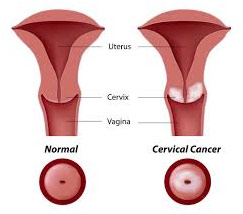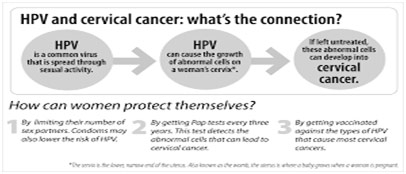1. What is cervical cancer?
A- Cervix is the lowermost end of the uterus, which connects the uterus with the vagina. When cancer starts in the cervix, it is known as cervical cancer.

2. How common is it in Bangladesh?
A- Cervical cancer ranks as the second cause of female cancer in Bangladesh. Every year 122,844 women are diagnosed with cervical cancer and about 67,477 women die from the disease. The peak age for cervical cancer incidence is 55-59 years.
3. What causes cervical cancer?
A- Human papilloma virus infection has been found to be a necessary but not sufficient cause for the cervical cancer, which is acquired through close skin to skin contact as during unprotected sexual contact with the infected individual

4. How common is HPV infection?
A- HPV is associated with 50,000 new cases of cervical cancer and 250,000 associated cervical cancer deaths worldwide each year. In Bangladesh, 87.8% to 96.67% of women with cervical cancer have an HPV infection. It is most common in the age group of 26-35 years.
5. What are the risks to get cervical cancer?
- Early age at marriage
- Multiple sexual partners,
- Multiple pregnancies
- Poor genital hygiene
- Malnutrition
- Lack Of Awareness
6. What are the early signs of the cervical cancer?
A- One should be watchful of the following signs:
- Bleeding between periods
- Bleeding during or after sex
- Any unpleasant vaginal discharge
- Bleeding after menopause
- Discomfort or pain during sex
7. What are the methods available to screen cervical cancer?
- Pap smear
- VIA (visual inspection with acetic acid)
- VILI (visual inspection with lugol’s iodine)
- HPV DNA test
All these tests are very simple and only take only around five minutes. They usually are not painful although some women may find them bit uncomfortable.
8. How are these tests performed?
A- These tests basically screen out the suspicious cells at the cervix. This is done by several methods as following:
- Taking the sample of the abnormal cells at the cervix with a brush and examining it under the microscope (Pap smear).
- Staining the cervix with the dilute acetic acid (vinegar) and looking for distinct white areas which are suggestive of abnormal cells.
- Taking the sample from the cervix to look for the presence of the human papilloma virus (HPV) which is responsible for causing cervical cancer in most of the cases.
9. Where are these tests performed?
A- They can be easily performed by the doctors at all the district level hospitals. It requires very minimal time and just the slight discomfort.
10. Why is cervical cancer screening important?
A- According to the studies, HPV infection might take about a decade to progress to the invasive cancer, therefore giving enough time for the preventive methods. About 5000-6000 lives are saved every year by the simple screening methods.
| STAGE OF CANCER | 5 YEAR SURVIVAL RATE |
| 0 | 93% |
| 1A | 93% |
| 1B | 80% |
| 2A | 63% |
| 2B | 58% |
| 3A | 35% |
| 3B | 32% |
| 4A | 16% |
| 4B | 15% |
In order to define the outlook of the cervical cancer, the term 5 year survival rate is usually used i.e. the percentage of people who would live for atleast 5 years after their cancer is diagnosed. The rates in table no. 2 were published in 2010 in the 7th edition of the AJCC staging manual and give the latest data of the survival rate.
As seen in the table, it is very clear if diagnosed in the early stages, this cancer has very good prognosis and poor outlook if diagnosed late. Here lies the importance of the screening , if done timely, it averts a big trouble.
11. How can cervical cancer be prevented?
A- It can be prevented through following methods:
- There are 2 types of the vaccines available to prevent the HPV infection: cervarix and Gardasil. Both are equally effective. The ideal recommended age group for vaccination is 12-26 years; before the first sexual debut. Maximum effectiveness is between 9-13 years. Three injections are given over six months. The vaccine protects against the two types of HPV that cause 7 out of the 10 cervical cancer cases, however, since it doesn’t protect against all types of the HPV, cervical screening is still important.
- Getting yourself screened on the regular basis.
- Follow up with the doctor if the screening tests reports were not normal.
- Avoiding the high risk behaviour.
